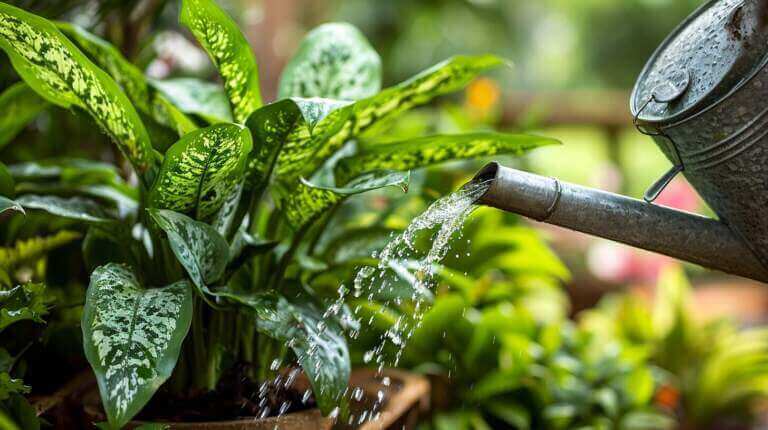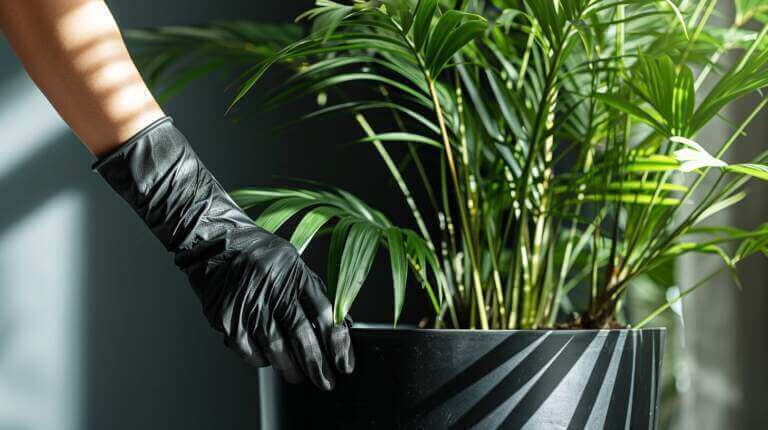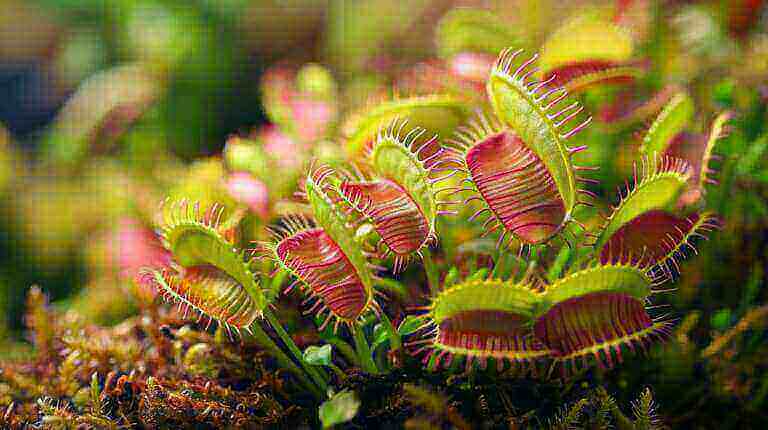Why Peace Lily Leaves Turn Yellow or Brown? Reasons Your Peace Lily Leaves Are Turning Yellow Leaf
Are the leaves of your peace lily turning yellow? Don’t panic, as you’re not alone. Many plant enthusiasts face this issue and wonder what steps to take.
In this article, we will explore the common causes behind yellowing peace lily leaves and provide practical solutions to address the problem. By understanding the underlying factors, such as nutrient deficiencies, overwatering, and improper light levels, you can restore your peace lily’s leaf health and experience the joy of a thriving indoor plant.
Key Takeaways
- Yellow peace lily leaves can be caused by improper watering, inadequate lighting, pests, diseases, and low humidity levels.
- Different leaf discolorations can indicate potential causes such as overwatering, underwatering, excessive sunlight, low humidity, root rot, pests, or excessive fertilizer.
- Nutrient deficiencies can be identified by observing leaf discoloration and growth patterns, and can be treated by adjusting soil pH, adding organic fertilizers or supplements, or modifying watering practices.
- Overwatering and root rot issues can be managed by watering plants only when the top inch of soil feels dry, ensuring proper drainage, and avoiding overwatering and ensuring good air circulation.
Common Reasons For Peace Lily Leaves Turn Yellow or Brown
One of the most prevalent reasons your peace lily leaves turn pale yellow and eventually dead leaves can be attributed to various common causes such as improper watering or inadequate lighting. However, another important factor that can lead to yellowing leaves is the presence of pests and diseases.
Peace lilies are susceptible to pests such as aphids, mealybugs, and spider mites, which can feed on the leaves and cause discoloration. These pests can be controlled using insecticidal soaps or neem oil, which are safe and effective treatments.
In addition to pests, diseases can also affect the health of peace lily leaves. One common disease is leaf spot, characterized by brown or black spots on the leaves. This can be caused by overwatering or poor air circulation. To prevent leaf spot, it is important to ensure that the plant is not sitting in water and to provide adequate airflow around the leaves.
Another important factor to consider when dealing with yellowing peace lily leaves is humidity. Peace lilies are tropical plants, where healthy peace lilies thrive in high humidity environments. When grown indoors, they thrive in environments with humidity levels between 40% and 60%. If the humidity drops below this range, the leaves may start to turn yellow. To increase humidity, you can place the plant on a tray filled with water or use a humidifier.
Understanding Peace Lily Leaf Health
To better care for peace lilies, it is crucial to comprehend the factors that contribute to their leaf health. One of the key factors that can greatly impact the health of peace lily leaves is watering frequency. Peace lilies thrive in moist soil, but overwatering can lead to root rot and yellowing leaves. On the other hand, underwatering can cause the leaves to become brown and crispy. Finding the right balance is essential for maintaining healthy leaves.
Another common issue that peace lily owners face is leaf discoloration. The table below provides a visual representation of the different leaf discolorations and their potential causes:
| Leaf Discoloration | Potential Causes |
|---|---|
| Yellowing Leaves | Overwatering, underwatering, too much direct sunlight |
| Browning Leaves | Underwatering, low humidity, excessive heat exposure |
| Blackened Leaves | Root rot, fungal diseases, overwatering |
| Spotted Leaves | Pest infestation, fungal or bacterial infections, excessive fertilizer |
Understanding these potential causes can help identify and address the underlying issues that may be affecting the leaf health of peace lilies. By adjusting watering frequency, providing adequate humidity, and addressing any pest or disease problems, peace lily owners can ensure that their plants maintain vibrant and healthy leaves.
How to Identify Yellow Peace Lily Leaves and Treat Nutrient Deficiencies
Identifying and treating nutrient deficiencies in plants requires careful observation and analysis of leaf discoloration and growth patterns. When plants lack essential nutrients, such as nitrogen, phosphorus, or potassium, it can manifest as yellowing or discoloration of leaves, stunted growth, or weakened overall health. To identify deficiencies, examine the leaves for any abnormal coloration or patterns. For example, yellowing between leaf veins may indicate an iron deficiency, while yellowing of the entire leaf may suggest a nitrogen deficiency. Once deficiencies are identified, corrective measures can be taken. This may involve adjusting the pH of the soil to enhance nutrient availability, adding organic fertilizers or supplements specifically formulated for the lacking nutrient, or modifying watering practices to ensure proper nutrient uptake. Regular monitoring and adjustment are crucial to effectively correct deficiencies and maintain plant health.
Transition:
In addition to identifying and treating nutrient deficiencies, managing overwatering and root rot issues is equally important in maintaining the health of plants.
Managing Overwatering and Root Rot Issues
Regularly monitoring and promptly addressing overwatering and root rot issues are essential for ensuring the optimal health and growth of plants. Overwatering can lead to root rot, a fungal infection that affects the roots and can cause serious damage or even death to the plant.
To effectively manage overwatering and root rot, consider the following tips:
- Proper watering: Water your Peace lily houseplants only when the top inch of soil feels dry. Avoid overwatering by ensuring proper drainage in the pots or containers.
- Soil moisture monitoring: Use a moisture meter or stick your finger into the soil to check if it is dry. This will help you determine when it’s time to water your plants.
- Adequate drainage: Ensure that your pots or containers have drainage holes to allow excess water to escape. Additionally, use well-draining potting soil to prevent water from pooling around the roots.
- Fungal infection prevention: Avoid overwatering as it creates a favorable environment for fungal infections. Also, ensure good air circulation around your plants to discourage the growth of fungi.
Tips for Proper Light and Temperature Levels
Effectively managing the proper light and temperature levels is crucial for maintaining the optimal health and growth of plants, and therefore, it is essential to carefully monitor and adjust these factors accordingly. Maximizing growth and avoiding direct sunlight are key considerations when it comes to providing the right conditions for plants.
Light is a vital factor for plant growth as it is necessary for photosynthesis. However, too much direct sunlight can be harmful to certain plants, causing their leaves to scorch and their growth to be stunted. To ensure plants receive the right amount of light, it is recommended to place them in areas with bright, indirect light. This can be achieved by placing plants near windows or using artificial grow lights when natural light is limited.
On the other hand, temperature plays a significant role in plant growth and development. Different plants have different temperature preferences, but in general, most indoor plants thrive in temperatures between 60-75°F (15-24°C). It is important to avoid exposing plants to extreme temperature fluctuations, as this can stress them and hinder their growth. Monitoring the temperature and making adjustments when necessary can greatly contribute to the well-being of plants.
To summarize the information above, the table below provides a practical guide for maximizing growth and avoiding direct sunlight:
| Light | Temperature |
|---|---|
| Bright, indirect light | 60-75°F (15-24°C) |
Frequently Asked Questions
What Are the Symptoms of Root Rot in a Peace Lily?
Root rot in a Peace Lily can be detected through various symptoms. Yellowing leaves, slimy roots, and a foul odor indicate the presence of this problem. To prevent root rot in peace lily, it is crucial to ensure proper drainage, avoid overwatering, and use well-draining soil. Additionally, maintaining a suitable humidity level and providing adequate air circulation can help keep this destructive condition at bay.
What Are the Common Causes of Peace Lily Leaves Turning Brown?
Peace lily browning leaves can be caused by overwatering, underwatering, or insufficient humidity. Root rot, due to waterlogged soil, is a common culprit. Using tap water with chlorine or fluoride can also lead to leaf discoloration. Insufficient light or excessively high temperatures may stress the plant, causing leaf browning. Regularly monitoring watering, adjusting light exposure, and maintaining proper humidity levels can help prevent this issue.
Is It Normal for Leaves On Your Peace Lily to Turn Yellow During Certain Seasons?
It is not uncommon for peace lily leaves to turn yellow during certain seasons. This can be attributed to natural processes such as aging and shedding of older leaves. However, there are several common causes of yellowing peace lily leaves that should be considered.
These include overwatering, underwatering, excessive exposure to sunlight, and nutrient deficiencies. To prevent yellowing of peace lily leaves, it is important to maintain proper watering and lighting conditions, provide adequate nutrients, and regularly inspect the plant for signs of pests or diseases.
Can Using Tap Water or Hard Water Cause Yellowing of Peace Lily Leaves?
Using tap water or hard water can indeed cause yellowing of peace lily leaves. Tap water often contains minerals and chlorine that can accumulate in the soil and affect the plant’s health.
Hard water, which has high levels of calcium and magnesium, can also lead to leaf discoloration.
To prevent this, it is recommended to use distilled water or rainwater, which are free from these impurities. Regularly flushing the soil with distilled water can also help remove any mineral buildup and maintain the health of peace lily leaves.
Why are my peace lily houseplant leaves turning yellow?
Peace lily leaves can turn yellow due to various reasons such as overwatering, underwatering, lack of nutrients, or exposure to direct sunlight.
What causes the leaves on my peace lily to turn brown?
Brown tips or brown leaves on a peace lily plant may be a sign of underwatering, low humidity, or exposure to direct sunlight.
How can I fix the yellow leaves on your peace?
To fix yellow leaves on your peace lily, adjust your watering schedule and ensure the plant is not exposed to direct sunlight. If the issue persists, you may need to repot your peace lily plant.
Why is my peace lily drooping leaves?
A peace lily may droop due to underwatering or overwatering. Check the soil moisture and adjust your watering schedule as needed.
How can I prevent my peace lily leaves from turning yellow?
To prevent yellow leaves, ensure your peace lily is watered properly and is not exposed to direct sunlight. Regularly fertilize your plant during the growing season.
How often should I repot my peace lily plant?
Peace lilies typically need to be repotted every 1-2 years, but this can vary depending on the growth rate of your specific plant.
Why are the lower leaves on my peace lily turning yellow?
It’s natural for older, lower leaves on a peace lily to turn yellow and die off as the plant grows. However, if many leaves are turning yellow at once, it could indicate a problem such as overwatering or a nutrient deficiency.
What is the common cause for yellow leaves on a peace lily?
The most common cause of yellowing leaves among peace lilies is improper watering. Peace lilies prefer evenly moist soil. However, overwatering can cause the roots of your peace lily to rot, which can lead to yellowing of leaves.
What are the reasons for yellow tips on the leaves of a peace lily?
Yellow tips on peace lilies’ leaves often indicate over-fertilization or poor water quality. Peace lilies don’t need much fertilizer, and too much can cause the leaf tips to turn yellow.
Why do the leaves on a peace lily turn brown?
Brown spots or brown leaf tips often indicate that the peace lily isn’t getting the right amount of light or water. Peace lilies like bright, indirect light and consistent watering.
How can a gardener fix yellow leaves on a peace lily?
To fix yellow leaves, first identify the cause. If it’s due to overwatering, reduce watering frequency. If it’s due to lack of light, move your peace lily indoors to a brighter location. Remove yellow leaves to promote new growth.
Why do old leaves on a peace lily turn yellow?
It’s natural for old leaves to yellow and die off as the plant matures. This allows the plant to focus energy on new growth. If only old leaves are turning yellow, this is likely the reason.
How can I keep my peace lily green?
To keep your peace lily green, ensure it gets bright, indirect light and keep the soil consistently moist but not waterlogged. Peace lilies also prefer high humidity.
Why Does Overwatering Cause Peace Lily Leaves to Turn Yellow?
Overwatering peace lily plants can lead to yellow leaves. Excessive watering causes oxygen deprivation in the roots, leading to root rot. As a result, the leaves lose their vibrant green color and turn yellow. To prevent this, ensure proper drainage and only water the plant when the top inch of soil feels dry.
Why do new leaves on my peace lily have yellow spots?
Yellow spots on new leaves could be a sign of a pest problem or disease. Inspect your plant closely for signs of pests like aphids or scale.
Why don’t my peace lilies grow green leaves?
If your peace lilies aren’t growing green leaves, they might not be getting enough light. Move them to a brighter location but avoid direct sunlight.







